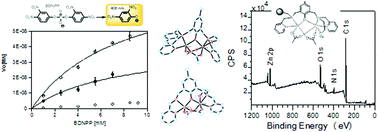Asymmetric zinc(ii) complexes as functional and structural models for phosphoesterases†
Abstract
We report two asymmetric ligands for the generation of structural and functional dinuclear metal complexes as phosphoesterase mimics. Two zinc(II) complexes, [Zn2(CH3L4)(CH3CO2)2]+ (CH3HL4 = 2-(((2-methoxyethyl)(pyridin-2-ylmethyl)amino)methyl)-4-methyl-6-(((pyridin-2-ylmethyl)amino)methyl)phenol) and [Zn2(CH3L5)(CH3CO2)2]+ (CH3HL5 = 2-(((2-methoxyethyl)(pyridine-2-ylmethyl)amino)methyl)-4-methyl-6-(((pyridin-2-ylmethyl)(4-vinylbenzyl)amino)methyl)phenol) were synthesized and characterized by X-ray crystallography. The structures showed that the ligands enforce a mixed 6,5-coordinate environment in the solid state. 1H-, 13C- and 31P-NMR, mass spectrometry and infrared spectroscopy were used to further characterize the compounds in the solid state and in solution. The zinc(II) complexes hydrolyzed the organophosphate substrate bis-(2,4-dinitrophenol)phosphate (BDNPP), the nucleophile proposed to be a terminal water molecule (pKa 7.2). The ligand CH3HL4 was immobilised on Merrifield resin and its zinc(II) complex generated. Infrared spectroscopy, microanalysis and XPS measurements confirmed successful immobilisation, with a catalyst loading of ∼1.45 mmol g−1 resin. The resin bound complex was active towards BDNPP and displayed similar pH dependence to the complex in solution.


 Please wait while we load your content...
Please wait while we load your content...